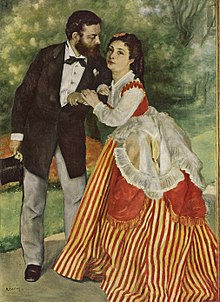Barbazanges Gallery
The Barbazanges Gallery was an important impressionist gallery in Paris at the beginning of the 20th century .
history
The founder was Henri Barbazanges, who ran the gallery in an empty, extensive factory complex owned by Paul Poiret at 109, Faubourg St -Honore. The buildings were constructed in the late 18th century. The gallery had its entrance at 26 Avenue d'Antin and “consisted of a room at the front and several rooms at the rear, which merged into a 70 m² large and 5.5 m high room with no windows, but one Had skylight . ”A total of 250 square meters of exhibition space was available.
Exhibitions
Robert Delaunay's first solo exhibition took place in February and March 1912, showing 41 works, including four depictions of the Eiffel Tower . Even Marie Laurencin could exhibit some of their works. A small catalog appeared with a text by Maurice Joseph Princet , eight illustrations and a list of the works on display. In 1916 André Salmon organized the exhibition L'Art modern en France (the so-called Salon d'Antin ) in which 152 contemporary pictures were shown. This exhibition was the first public presentation of Pablo Picasso's Les Demoiselles d'Avignon , which was given its own wall. Henri Matisse showed two paintings, Amedeo Modigliani was represented with three portraits, Marie Vassilieff with eight works and Max Jacob with two landscape pastels. Jacqueline Marval showed Les Odalisques . The exhibition met with an enormous response in the press.
In 1919 the gallery showed exhibitions with works by Larionow and Natalia Goncharova , as well as by Paul Gauguin . On March 8, 1920, a play by Max Jacob was staged as part of an exhibition of children's drawings ( Schöne Aussichten ). During the break, the world premiere of Musique d'ameublement ("Music for furnishings") by the French composer Erik Satie , which is considered to be the earliest known sound installation .
Henri Barbazanges was mainly active as an art dealer and supplied numerous European museums. In 1912 the Wallraf-Richartz-Museum bought the painting The Sisley couple by the painter Auguste Renoir from him . In 1919 he bought the painting The Atelier from Gustave Courbet , which he sold to the Louvre a year later and which now hangs in the Musée d'Orsay . In 1924, together with his colleague Georges Bernheim, he acquired the entire studio inventory of Pierre-Auguste Renoir, who died in 1919 . Numerous other paintings, such as Vincent van Gogh's self-portrait from 1887 (oil on canvas, 47 cm × 35.5 cm), were arranged through Barbazanges.
Gallery Barbazanges-Hodebert
In 1923, Barbazanges left the company to his colleague M. Hodebert, and from then on the gallery operated as Galerie Barbazanges-Hodebert . In the same year there was an exhibition of the private collection of Paul Poiret, the landlord, who had run into financial difficulties and had to part with some of his holdings. Marc Chagall came to Paris in 1923 . The gallery showed his works for the first time in 1924: Marc Chagall 1908–1924 in a comprehensive exhibition. In 1925, Hodebert showed the early oeuvre of Maurice Utrillo , which comprised 63 works from the period from 1910 to 1914.
Pierre Matisse found his first job here in 1923 before moving to New York in 1924, where he founded his own gallery in 1931.
The archive of the Galerie Barbazanges-Hodebert from the period between 1920 and 1930 has been in the Musée d'Orsay in Paris since 1994. It consists of around 800 pages and 1000 photos.
Web links
Individual evidence
- ↑ Billy Klüver, Jean Cocteau (photos), Udo Kittelmann, Thomas Buchsteiner: A day with Picasso: August 12, 1916. Edition Cantz, 1993, ISBN 978-3-89322-527-9 , pp. 72 ff.
- ^ Peter-Klaus Schuster, Susanne Bäumler: Delaunay and Germany. DuMont Buchverlag, Cologne 1985, ISBN 3-7701-1774-3 , p. 30
- ^ Issue 3 authors William Stanley Rubin, Hélène Seckel: Les Demoiselles d'Avignon. Museum of Modern Art (New York, NY), Harry N. Abrams, 1994, ISBN 978-0-8109-6125-8 , p. 122
- ↑ S. Ebert-Schifferer, Ingo Begall: Way in the abstraction. Cantz, 1987, ISBN 978-3-922608-63-9 , p. 192
- ^ The Paul Gauguin exhibition in the Barbazanges Gallery in 1919 . In: Paul Gauguin - From Brittany to Tahiti. A departure for modernity. Landesmuseum Joanneum, Graz, 2000 ISBN 978-3-902018-02-1 , p. 119
- ↑ Grete Wehmeyer: Erik Satie. Brucknerhaus Linz, Linz Event Company, 1986, p. 59
- ↑ Otto H. Förster, Hans W. Hupp, Aenne Liebreich: Guide through the painting gallery of the Wallraf-Richartz-Museum. Dumont Schauberg, 1927, p. 125, inv. No. 1199
- ↑ Julius Meier-Graefe, Ingrid Grüninger: Art is not there for art history - letters and documents. Wallstein Verlag, Göttingen 2002, ISBN 978-3-89244-412-1 , p. 457
- ↑ Billy Klüver, Jean Cocteau (photos), Udo Kittelmann, Thomas Buchsteiner: A Day with Picasso: August 12, 1916. Cantz, 1993, ISBN 978-3-89322-527-9 , p. 91
- ↑ Pierre Matisse Gallery , metmuseum.org, accessed on February 1, 2016


